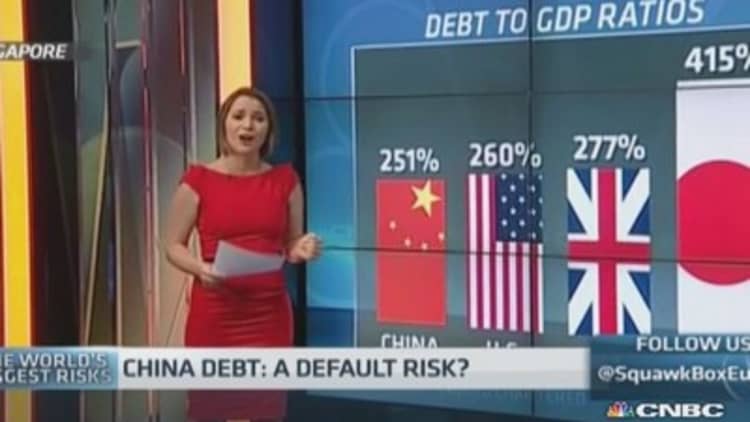Investors are increasingly worried about the risk of defaults in China as the country's debt pile accumulates while the economy slows, but analysts say Beijing can manage for now.
"The risks are manageable. Much of what goes on in China is controlled by the government. And the government has plenty of firepower to ensure growth holds up," said AMP Capital's head of investment strategy and chief economist Shane Oliver in a note published on Tuesday.
The risk of debt defaults in China overtook the threat of deflation in the euro zone as the second biggest "tail risk" among investors, according to a Bank of America Merrill Lynch global investor survey published on Wednesday.
China's total debt grew from 141.2 trillion at the end of 2013 to 153.7 trillion yuan at the end of September 2014, or 247 percent of gross domestic product (GDP), according to Morgan Stanley's calculations.
But that concern appears overblown.
"China's central government has the financial capacity to handle a financial crisis if one materializes—government debt is only 55 percent of GDP," a McKinsey Global Institute research note published in early February said.
Sharper slowdown
China's government is in a bind: It needs to reduce debt and has the firepower to do so, but risks slowing the economy if it takes action.
In March, Beijing acknowledged economic momentum was slowing when it set its 2015 GDP growth target at "around 7 percent" – the lowest level in 11 years.

The latest data suggest growth is in fact slowing: In February, new home prices fell 5.7 percent on year – their sixth straight decline – according to Reuters calculations. Housing contributes to about 15 percent of China's economy.
"The ongoing restructuring and deleveraging of China's economy has so far happened in slow motion as the government has been careful to avoid a crash landing," Societe Generale said in a note published on Wednesday.
Local government debt
But as local government debt mounts, Beijing's balancing act could get bumpy.
With limited authority to raise taxes, China's local authorities have been funding infrastructure projects, such as transportation and social housing, by borrowing through off-balance sheet financing vehicles.
Local government debt represents around 23 percent of China's total debt, according to a Morgan Stanley note.
The central government has audited local governments in an effort to bring the problem under control, but analyst say the effort could slow economic growth.
Any attempt to bring local authority debt under control would "further slow local government infrastructure spending growth. While that should help getting local government debt under control, it is not necessarily positive for near-term economic growth," Societe Generale said.
And so the government will have to tread carefully to manage the country's debt load.
"China's deleveraging looks set to stay a long and bumpy ride," the Morgan Stanley note said.

